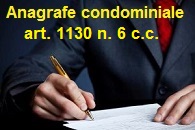
Condominium registry
The condominium registry is one of the most significant changes introduced by the reform of the building (Art. 1130 n. 6 cc)
It consists of a registry that the administrator is obliged to keep updated with the active collaboration of condominiums, and must contain:
- a) the identity of the owners and holders of real and personal rights of enjoyment inclusive of the tax code and residence or domicile;
- b) cadastral data of each housing unit;
- c) all data related to safety conditions of the common parts of the building (the reference to the common parts of the building has been included in art. 1130 n. 6 cc by the Decree Law 145/2013, so that decree Destination Italy) .
It was mentioned the necessity of cooperation of condominiums. In essence, the procedure for the initial training and the update of the condominium registry registry is as follows:
- a) the administrator asks condominiums such data, specifying a period for fulfillment;
- b) condominiums respond to the request by filling out the form sent to him by the administrator (you do not need to submit a form, but the practice has led to this sealing mode).
If you are upgrading, for example, change of residence or conductor up to the condominium act to the first, because the administrator may not always be aware of these changes.
In the event of failure or incomplete communication of data by the condominium – as in the case of initial training, as for updating the register – the administrator prior reminder by registered mail return receipt You can act on its own to retrieve the requested data by laying the all’inadempiente expenses.
Example: Dude does not communicate his residence or cadastral data of its property unit.
In this case the administrator can find this information at the registry office and the land registry, thereby charging the cost of these certifications to Tom.
If the remuneration statement at the time the appointment was scheduled an entry for this activity, then the administrator can also ask the condominiums this compensation, in addition to the expenses necessary to obtain the missing information.
Data conductors and related issues
If you find information on the cadastral data, residence and existing real rights on real estate units is not a problem, for what are the registry office, land surveying and public property registers, the same can not be said for the personal rights of enjoyment on ‘housing unit.
One above all: the lease. To date there is no public a register of leases in place, so that those who want to know whether a particular housing unit is occupied by a tenant would not have another tool to inquire of the parties concerned.
Since the leases in residential use for a period exceeding thirty days must be registered with the Inland Revenue, theoretically it is possible to ask the Court to order the said institution to provide this information to the applicant that the judge allowed considering it (see Annex. Presidential Decree 131/86).
A long and expensive procedure that, in fact, has never been used, at least, has not been used by the building managers.
These, in fact, had not user-friendly tools to get information on the existence of the lease contracts, better get the data of the conductors, if landlord and tenant not hand them indicated.
Condominium registry, lease and Stability Act 2016
The law is stable for the year 2016 (l. N. 28 December 2015, n. 208, published in the Official Journal on 30 December 2015) has partially remedied this problem, or at least that was the intention of the legislator.
Article. 1, fifty-ninth paragraph l n. 208/2015 intervened amending art. 13, first subparagraph l. n. 431/98 (concerning the leases for residential purposes). This rule now reads: …. E ‘taken charge the landlord to provide the registration within a period of thirty days, by giving notice documented in the following sixty days, the tenant and the administrator of the condominium, including for purposes of the the obligations of the Registry held condominium in Article 1130, number 6), of the civil code.
In essence, it is imposed on the owner of the property to communicate to the condominium of the registration of the contract.
This means you will no longer be sufficient to notify the administrator the name of the conductor, but within sixty days from the registration of the contract must also communicate the details of this fulfillment. The fact that communication should be documented would seem to refer to the need to attach to the communication copy of the registration receipt or at least an extract.
This document must become part of the condominium registry registry, as it is the same rule to impose it by specifying that the notice should be documented also fulfilled the purpose of the Association of the Registry held.
And if the owner does not act in this way, that is not communicating the administrator of the registration?
Then the administrator can take judicial action requesting the issuance of an injunction.
It is clear, at least in the opinion of the writer, that the rule has not solved the underlying problem, ie the possibility for the condominium administrator, in the absence of effective cooperation of stakeholders, with certainty about the conductor’s name, not being still existing public a register of leases that allows to give answer to this question.
As if to say: if the owner does not communicate anything, the administrator does not have the tools allow you to confirm this information, as well as for the residence them, cadastral data, etc. etc.
GECOSEI of Giuseppina Napolitano

